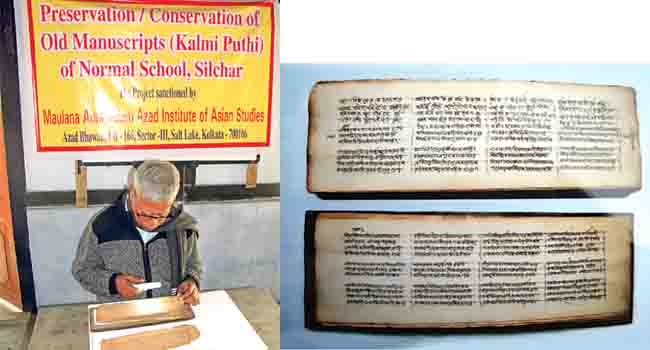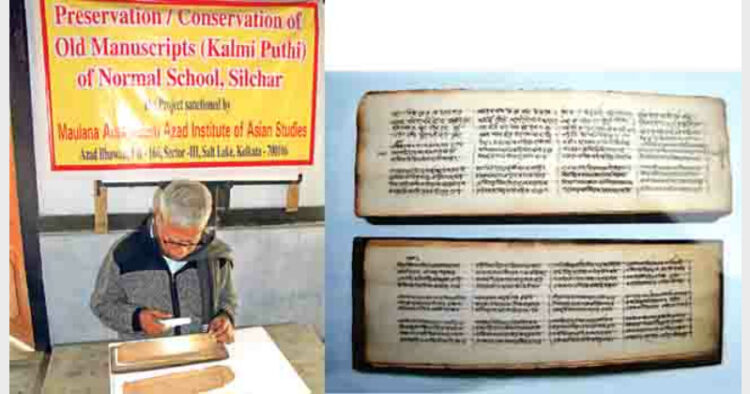
Dr Amalendu Bhattacharjee at work, Manuscripts of more than two hundred years old
The rare manuscripts being preserved in Silchar are invariably the treasure-trove of knowledge. They reveal the nature of education, profound knowledge of Sanskrit and Bengali of the enlightened section of society of the time
Jyoti Lal Chowdhury, Silchar
Normal school of the town, known as teachers’ training school, established in 1906 has always attracted scholars and research workers for it being the treasure trove of old manuscripts of rich academic value. But, sadly enough there has been little or no effort from any quarters for their preservation. Lying in a state of neglect and being subjected to wear and tear of time, not all manuscripts could be preserved properly. Before all is lost in the abysmal of time, Maulana Abul Kalam Institute of Asian Studies (MAKAIS) Kolkata has come forward for the preservation and conservation of old manuscripts. Its Chairman Dr Sujit Kumar Ghosh deserves all kudos for taking the initiative in this direction.
But not before making a critical appraisal of the project to be taken up. Dr Amalendu Bhattacharjee, former Head, Department of Bengali in the premier centre of higher education, Gurucharan College and a well-known exponent of folk literature, was entrusted with the onerous responsibility of recreating the manuscripts and regaining their glory. Known for his keen scholastic interest in research works, Bhattacharjee as the project-in-charge, started his project work in April 2019 assisted by a team of dedicated research assistants, Ratna Nandi, Mahua Chandra, Anindita Kar, Ankita Biswas and Bhaskar Sharmacharjee. All of them have been trained in calligraphy, manuscript reading, their identity and knowledge of alphabet first at Normal School and then in Kolkata. Cataloguing work started from May 1, 2019.
It is interesting to know that hand-written manuscripts on varied subjects, as Dr Amalendu Bhattachajee said, were collected by some teachers between the period 1910 and 1940 from South Assam. According to him, till date manuscripts in two languages, Bengali and Sanskrit, have been found. In these two languages, the primary identity of more than 500 manuscripts could be established. More manuscripts remain to be searched and brought to light. Manuscripts in Sanskrit have also been taken up for study. Most of the manuscripts are preserved in ornamental and artistically designed covers, a soothing treat for the eyes.
The manuscripts in Bengali discovered by the research team of Dr Bhattacharjee are on Ramayana, Mahabharata, Puranas, Gita, Vaishnava Literature, Mangal Kabya, Pachali, Yoga Shastra, Occult Science and miscellaneous. In Sanskrit, manuscripts found are on Mahabharata, Vyakaran, Smriti Shastra and Karma Kanda. There are also some fragmented manuscripts. The study has revealed that the manuscripts are two hundred years old. But, the oldest manuscript is on Smriti Purana, which has been copied in 1688.
Names of some of the poets so far known are Sanjay (Mahabharata), Shasthi Var, Bardhaman Dutta, Chandravati (Mansa Mangal), Bhavananda Das, Bhavani Das, Adbhut Acharya (Ramayana), Bhubaneshwar Vachaspati (Puran), Brajakishore Das, Basudeva Ghosh, Gourchand Deb (Vaishnav Sahitya), Dwij Ram Krishna, Manohar Sen (Pachali) among others. According to the tradition of manuscript-writing, the necessary information of a manuscript is given on the last page which is called ‘Puspika’.
‘Puspika’ of many manuscripts has either been lost or destroyed. From the ‘Puspika’ of the manuscripts found, it has been leant that manuscripts were written in different parts of Barak Valley. These places are Dudhpatli, Bicrampore, Chapghat, Kazidahar, Suprakandi, Borband, Kushiarkul, Borjuari, Majhirgam among others. These were the centres of studies and knowledge.
“We find traces of enriched knowledge of a section of enlightened people when no centres of higher studies or university in the region existed. Much light has been thrown on the trends of medieval literature. This is, in fact, the extension of ancient Indian culture and tradition in this remote area of the country. Quite amazing is the regional contributions towards classical epics like Ramayana and Mahabharata,” pointed out Dr Bhattacharjee.
It is also interesting to know that the manuscripts were sold. Two such manuscripts have been found. After the death of the writers, their wives in financial distress sold the manuscripts. This has been honestly admitted by the widows in distress and the persons who bought the manuscripts, said Dr Bhattacharjee. The manuscripts are also reflective of the commitment to native land. In the manuscript entitled ‘Mahiravener Yudha’, the author Dvija Gangaram has given a vivid description of his village where there are references of Siddheswar temple, Barak River, etc. The date of the manuscript is 1828.
It is significant that much light has been thrown on the evolution of language and spelling, the structure of the language of the time. Many sided research has been done. This has brought into focus Gita’s different episodes like Gyan Gita, Pandava Gita, Narad Gita and Arjun Gita. In fact, there have been attempts to conserve and preserve manuscripts two times funded by National Mission of Manuscripts. But, as Dr Amalendu Bhattacharjee said, “It was just an exercise to clean up and dust off and nothing more.” Before Dr Bhattachajee, two other scholars who did research work on manuscripts were Jatindra Mohan Bhattacharjee and Anurupa Biswas.
The manuscripts are invariably the treasure-trove of knowledge. They reveal the nature of education, profound knowledge of Sanskrit and Bengali of the enlightened section of society of the time. Amazingly, scripts are still clear, free from worming due to protective measures. Bhattacharjee said, “After the publication of the descriptive catalogue of these manuscripts, cultural history of the region can be further studied by the scholars and research workers.” Dr Sujit Kumar Ghose, Chairman, MAKAIAS, Kolkata, said, “The most systematic and analytical works on manuscripts by D Amalendu Bhattacharjee and his team will open a new vista and horizon of knowledge in Assam, besides creating outreach for further studies.”













Comments